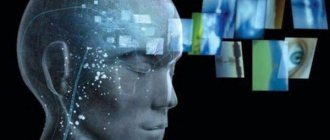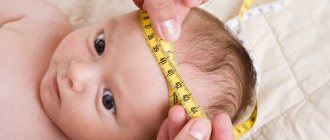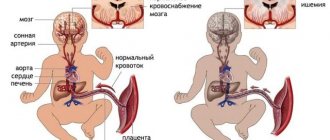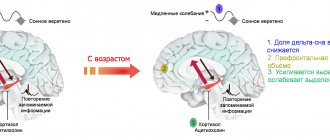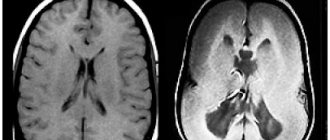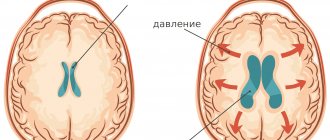A baby is born with most of the brain cells that this organ should have. In the first 12 months of life, the cerebrum (CB) becomes more complex; by the time it reaches 2 years of age, it has 75% of the weight of the adult brain. At the age of 3 years, the percentage of weight increases to 90%. Almost 50% of brain cells present at birth weaken or die during the first years. This process organizes and optimizes brain activity. Events in a child’s life provoke electrical impulses and create nerve fibers. The more fibers are used, the more stable an important organ becomes, the fewer neurons are susceptible to death. Similar to muscles, children's brains operate on a “use it or lose it” principle.
Brain waves
Brain waves are an expression of the frequency at which an organ operates. During the day they change, which causes a change in the person’s condition. Waves are divided into 5 types:
- delta;
- theta;
- alpha;
- beta;
- gamma.
All waves are active, consciousness is influenced by the dominant brain wave. Each wave type plays an important role in the formation of intelligence in childhood.
The activity and capabilities of the brain are described in a number of books by V.M. Bekhterev (they can be downloaded from many specialized sites).
Below is a diagram of wave frequencies and corresponding states of mind.
Beta (14-30 Hz):
- concentration, excitement, alertness, cognition;
- high levels are associated with anxiety, illness, loneliness, and arguments.
Alpha (8-13.9 Hz):
- relaxation, wakefulness, light trance, increased serotonin production;
- drowsiness, meditation, entering the subconscious.
Theta (4-7.9 Hz):
- REM sleep phase;
- increased production of catecholamines (important for learning and memory), increased creativity;
- integrative, emotional experiences, potential behavioral changes, increased knowledge retention;
- hypnotic imagination, trance, deep meditation, penetration into the subconscious.
Delta (0.1-3.9):
- "sleepless sleep";
- release of growth hormone;
- deep, non-physical state, trance;
- entrance to the subconscious.
Prenatal development
Consideration of the question of how a child’s brain develops should begin from the time the embryo is formed. It is formed in the womb from the anterior part of the neural tube, which appears in the 3rd week (20-27 days of development). The neural tube is formed by primary and secondary neurulation. At the head end of the neural tube, 3 primary cerebral recesses are formed - anterior, middle, posterior. At the same time, the frontal, parietal, and occipital lobes are created. The neural disc arises from the neuroectoderm.
At week 5, secondary medullary pads form, forming the main parts of the adult organ. The forebrain is divided into the intermediate telencephalon, the hindbrain into the medulla oblongata, pons, and cerebellum.
Gyrification of the hemispheres occurs sequentially. First, a longitudinal fissure is formed (determined by the fact that the hemispheres grow separately), then the lateral sulcus (separates the temporal lobe), after which the central sulcus.
Features of the prenatal stage of child brain development:
- Week 3: creation of a medullary (spinal) tube;
- Week 4: expansion of the proximal tube into 3 primary and 5 secondary follicles;
- Week 6: Neuroblasts begin to develop into mature neurons;
- 2nd month: the cerebellum, the base of the neurohypophysis, rhinencephalon (olfactory center), hippocampus, basal ganglia develop; at this stage, the cerebral hemispheres begin to develop;
- 3rd month: the corpus callosum begins to form;
- 4th month: brain development in children continues with intensive separation of the hemispheres (gyrification), an increase in their surface;
- then the children's brain experiences proliferation, differentiation, migration, maturation of nerve cells, growth of supporting elements; Myelination begins from the end of intrauterine life.
Child brain development: secrets of success
The formation of the human brain begins during fetal development. The peak activity of this process occurs in the first 12 months of life. It is important to understand that the degree of personal integrity depends on the fulfillment of a number of conditions that affect the coherence of all functions of the body. The successful development of a baby requires maximum effort from parents. The efforts made at this stage contribute to the transformation of the child into a self-confident person, clearly aware of his abilities and having a rich inner world.
Components of the brain
The formation of the brain occurs in a strictly defined order. At the initial stage, changes affect the brain stem, and at the final stage - the cerebral cortex.
Located at the base of the skull, the brain stem is responsible for many vital signs, including skin temperature and blood pressure. In its upper part is the midbrain, which controls sleep, appetite and motor activity. Maintaining balance and coordinating movements are controlled by the cerebellum, hidden behind the brain stem.
Memory, adaptability and emotions are assigned to the limbic system, called the central part of the brain. The top layer, the thickness of which ranges from 1.5-4.5 mm, is called the cerebral cortex. Thanks to it, the decision-making process is regulated.
The functions it performs also include control over such important processes for humans as speech and thinking. The cerebral cortex accounts for 80% of the brain's neurons. At the time the baby is born, the level of development of this part of the brain leaves much to be desired. Its improvement often continues after adolescence. It is the cerebral cortex that demonstrates the greatest degree of sensitivity to the impressions that befall the child.
Truth and fiction
Over the past decades, scientific luminaries have conducted many studies designed to reveal the secrets of the development of the human brain.
Thanks to their work, the world's population became aware that the brain activity of a three-year-old baby is twice that of an adult. Scientists have also proven that the predominant part of brain cells is formed during the stay of the fetus in the womb, and infancy and early childhood are characterized by the formation of a huge number of connections.
It was also possible to establish that during conversations with children who cannot speak, the foundation of language proficiency is laid, and learning at the stage of early critical periods of development shows the best results due to the ease of perception on the part of the child.
Nowadays, many doctors are convinced that most of all children need care, love and a sufficient number of new impressions. From this point of view, the priority remains with playing, singing, talking and reading together.
As practice shows, not a single toy can make up for the lack of live communication. This statement does not contradict the statement about the pricelessness of experience gained as a result of interaction with surrounding people and the environment. These factors are recognized as most beneficial during the developmental stage of the child's brain.
Nowadays, we no longer talk about the full development of the brain at the time of birth. Such a complex system works differently than the stomach or heart.
As it turns out, the genome laid down at conception is not the only factor influencing brain development. The list of false statements was also supplemented by the phrase about the lower brain activity of a baby taking his first steps compared to the level of brain activity of a university student. In addition, the myth regarding the need for special help and the importance of providing the baby with specific educational toys in order to develop thinking abilities was shattered. It also turned out that the importance of conversations with infants who do not have their own opinion regarding the subject of the conversation was previously underestimated.
Features of the development of the children's brain
As already mentioned, the initial stage of brain formation falls during the period of the fetus’s stay in the mother’s womb. On the day the physical connection with the mother is severed, accompanied by cutting the umbilical cord, the number of cells contained in this organ reaches an impressive 100 billion. An isolated existence excludes the presence of connections, the active process of formation of which begins after the first independent breath.
The most significant proportion of connections are formed during the first three years of life. In the future, there is a possibility that some of them will rupture. The degree of their strength depends on the amount of attention, care and love devoted to the little person. It is these elements that form the necessary basis, without which full development of the individual is impossible.
The number of neurons given to us by nature is approximately 20 times greater than the population of the Earth and 10 times greater than the number of stars included in such a large galaxy as the Milky Way.
Neurons are called the nucleus of the brain. The connections formed between them continue to remain one of the most interesting mysteries of the human body. The experience accumulated to date and fresh impressions include the mechanisms for the formation of the so-called brain circuit. The complexity of the network formed as a result of the interaction of individual cells with each other is most eloquently demonstrated by the fact that each of the tiny elements can communicate with 15,000 of its fellows.
At the stage of brain development, the first year of life is most significant. Constantly repeated calling by name contributes to the formation of connections in such a way that the baby, after a certain time, begins to perceive this name as a call that requires a response. Connections created at tremendous speed lay the foundation for our habits, memories, thoughts, minds and consciousness.
In the brain of a three-year-old baby, approximately 1000 trillion are generated. connections. Adults, oddly enough, are much “poorer” by this indicator (almost twice as much).
When a child reaches approximately eleven years of age, the process of getting rid of unnecessary connections begins in the brain. The environment and close relatives act as a stimulator for the growth of compounds and their further ordering. The learning structure reproduces repeated experience. Connections that have not been activated for a long time are subject to exclusion. There is a theory according to which positive or negative actions committed once have a certain impact on the development of the brain.
Daily use of connections during the first years of life transforms them into permanent units. Repeating stable verbal structures promotes speech recognition and strengthens language connections.
Stages of brain formation
The period of brain development can be divided into several stages:
- stay in the womb
- infancy stage,
- childhood
- and youth.
Each of these time intervals is unique. Successful completion of each of them is impossible without certain conditions. Failure to comply can result in serious problems.
Infancy is usually divided into 2 periods. The first (critical) period, which falls on 1-8 weeks, is considered more important. These days are allocated for the formation of visual functions. Violation of the norm of visual influence in the direction of its decrease increases the likelihood of poor development of nerve cells. Such complications can haunt a person for the rest of his life.
The longer sensitive period starts from six months and lasts up to approximately 24 months. It is characterized by facial recognition, a favorable attitude towards acquaintances and display of wariness towards strangers. At this stage, the baby’s attachment to his protective mother, who radiates warmth and love, is formed.
The curve reproducing the stages of brain formation has a wave-like structure. The nature of the line reflects the level of the brain's response to impressions. The higher this indicator, the more opportunities for brain development. The peaks of the bursts occur at different time intervals, corresponding to the most productive stages of brain development.
Periods favorable for learning are called “windows of opportunity.” On these days, information is received and processed more intensively than during periods of relative calm. A person hones skills in various fields of activity throughout his life. The learning process can only be interrupted by death.
The most fruitful period of brain development coincides with the first three years of life, extending into early childhood and adolescence. This is what explains the ease with which children learn the grammar of their native language, with which they come into contact every day. Learning at a later age turns out to be less effective due to the slower pace of learning. Children who take advantage of opportunities at the most suitable periods for acquiring knowledge will subsequently find it much easier to join the team and realize themselves.
Periods of skill formation
Parents should have an idea of the timing of this or that activity. Knowledge in this area will help determine the level of development of the baby. Shifting the timing involves contacting a doctor to avoid complications in the baby’s physical or mental condition.
Prolonged sleep and lack of obvious activity is the norm for babies 1-8 weeks old. After this period, children are characterized by multiple smiles and laughter. Over the next few months, head turns are replaced by rollovers. Four-month-old babies excel in this skill and make attempts to grasp objects at arm's length. Nine-month-old babies are already sitting with support, crawling and taking their first steps with the help of adults. The predominant part of one-year-old tomboys not only walk confidently, but also run quickly.
Caring for babies 0-12 months involves more than just feeding and dressing. Active intervention in the child’s life on the part of parents is encouraged. Responsible mothers begin to take care of the child already during pregnancy and include protein-rich foods in their diet. Their menu also includes food products that contain omega-3 acid. This element contributes to the normal functioning of brain cells and the formation of full connections between them.
The benefits of breast milk are legendary. The food supplied by the mother protects the baby from infections, develops its immune system and has a beneficial effect on brain activity.
A lack of love and attention is much worse than its excess. Fathers and mothers need to spend time with the child, sing him lullabies, read fairy tales and not let physical development take its course. Baby-safe toys with a pleasant-to-touch surface can be an excellent help. At the selection stage, it is advisable to give preference to developing varieties.
Parents can also play mimic games with their child, varying the intonation and strength of the voice. A baby observing the behavior of adults will subsequently be able to reproduce the emotions corresponding to a particular facial expression.
Reading is designed to sharpen listening skills and develop the ability to recognize emotions expressed by vocal vibrations. Understanding the material fades into the background. Lack of training also negatively affects the stimulation of visual functions. A child can learn to distinguish shades both at home and outside the apartment or house.
Loneliness is detrimental to a child. During waking hours, he needs the company of other people. The success of communication in the future depends on the fulfillment of this condition. A conversation with a child should not take place in elevated intonations. During a conversation, it is advisable to minimize exposure to distracting extraneous noise. Communication should be on a positive note. It is advisable to get rid of negativity in advance.
Maximum development of physical and mental capabilities guarantees the absence of difficulties at the stage of adaptation to society. The systematic development of children is observed in families that surround children with attention, warmth and love. At the same time, it is extremely important to perceive the baby as an equal partner with his own needs.
Hearing and vision
Abilities in recognizing sounds and visual images are formed before the age of 4-5 years. The importance of developing vision and hearing is difficult to overestimate, since it is these senses that help children perceive reality and contact the people and objects around them. During the first months, babies must look at moving and stationary objects of different colors and shapes. Thanks to this, the brain seems to learn to look. Equally important is the variety of sounds, a wide range of which contributes to the recognition and processing of information. At the end of these processes, in most cases a response should occur.
Language skills
Speech is formed during the first decade of life. The greatest effectiveness is observed during the first half of this period. Slurred babble and attempts to speak should not go unanswered.
Movement and physical development
During the first 12 years of life, children demonstrate physical readiness for various aspects of motor development. Often, walking skills are acquired much earlier than fine motor skills, which may include assembling puzzles and construction sets, modeling or drawing. It takes several years to develop coordination (playing with a ball). Some of the skills acquired in early childhood continue to be honed into adolescence.
Emotions and socialization
An identical period (12 years) is required for social and emotional development, expressed in the expression of trust and empathy, as well as the perception of other people. Rapid development of emotions is observed in the period 0-1.5 years, accompanied by the formation of a feeling of attachment to parents. The success of a fully formed personality depends on the correctness of emotional perception. Education received at an early age lays the foundation for an optimistic attitude, an active life position, empathy and the ability to be happy.
Parental support is extremely important for the social and emotional development of an individual. Social development is impossible without self-awareness and the ability to interact with other members of society. Their formation can be divided into several stages. For example, two-year-olds do not understand how and why they need to share toys. In children who have crossed the three-year threshold, this social skill is more developed.
Conclusion
Based on the above, a number of conclusions can be drawn. During the development of a child's brain, the power of daily experience, heredity, nutrition, physical activity and sensitive parenting should not be underestimated. The baby's brain is prone to development that is impossible without early experiences accumulated through touch, sight, smell, hearing and taste.
The listed feelings contribute to the building of meaningful connections. Early experiences contribute to the learning process by connecting neural circuits in the brain.
Patterned patterns help a newborn feel the presence of his mother, recognize his father’s voice or his favorite toy, etc. Sketches borrowed from the surrounding reality are subsequently subject to improvement and honing. Thanks to this, the connection between individual brain cells is strengthened.
Neonatal development of GM
Humans are the only mammals whose GM increases 3 times in size in the first 2 years of life. If it had been larger at birth, the baby's head would not have been able to pass through the birth canal. If the volume were small, the baby's life would be at risk.
Insufficient size of the brain is observed in microcephaly, an anomaly accompanied by mental impairment.
How does a child's brain develop before one year of age?
- at birth it weighs about 350 g, up to 1 year - about 1 kg;
- At birth, the brain has about 200 trillion neurons (nerve cells) - about the same as in adulthood;
- each neuron responds to stimulation of a growing system of dendrites (branched nerve cells) and synapses (the place where signals are transmitted from one neuron to another);
- each neuron ends in dendrites with approximately 15,000 synapses;
- dendrite formation becomes more complex over time, with 3-4 branches before the age of 6 months;
- the more stimuli the GM captures, the better the dendrites become;
- the anterior lobe (the part responsible for emotions) becomes metabolically active from 6 months (the neural basis of emotional intelligence is formed before 18 months);
- over the course of 2-4 months, the number of synapses in the visual center increases 10 times (approximately 20,000 neurons);
- up to 12 months, the neurons responsible for identifying the native language find their permanent place.
GM development during the first years of life
The newborn's brain is anatomically and functionally immature. During the breast period, it grows rapidly, the number of glial cells increases, and hydration decreases.
At the end of the 1st year, the weight of the GM doubles. The development of a child’s brain occurs intensively over the years; in the process of ontogenesis, innate unconditioned reflexes are replaced by conditioned ones.
At 3 years of age, the brain weighs approximately 3 times more than at birth. The ability of abstraction, learning, and memory is used; the child realizes his personality and becomes a social creature.
The first years of life are a critical stage for a child's brain development and provide the neurological foundation for intellectual development in adolescence and adulthood.
In the early years, children are very open to science through play. For young children, play is a way of preparing for a successful future life. Therefore, during this period, parental love and plenty of time spent together are important.
At 6 years of age, the weight of the brain is almost equal to the weight of the adult human brain (1250 g). The hemispheres are expressively grooved. Branching of neurons, myelination (creation of a covering that protects large nerve fibers from damage) are completed, memory and the ability to recreate memories improve. In the activity of the GM cortex, the ability of internal blocking is used; the child distinguishes between what he says, thinks, and reads.
During the first 8 years of life (especially the first 3 years), there are several critical periods for the acquisition of certain types of intelligence. If these “periods of opportunity” are closed, learning becomes more difficult, sometimes even impossible.
In adolescents, the GM grows mainly in the anterior lobes, its weight is about 1400 g.
Brain development from conception to adolescence
When my first child was born, I, as befits a zealous but young mother, collected a bunch of books about caring for babies and various progressive methods of education - so that my child would grow up to be a genius, and a happy one at that, I desperately needed authoritative advice. Unfortunately, it quickly became clear that most books were not particularly interested in explaining the biological basis of brain development. Let's try to figure out what science knows about the brain today and how modern pedagogy uses this knowledge.
Brain and its development
What is interesting in the development of the brain and what we, in fact, will observe at each stage of such development is the enormous interaction of genetically predetermined factors and environmental factors, which in the case of human development become factors of the social environment.
Embryonic development
In the human embryo, the brain begins to form from embryonic ectoderm tissue. Already on the 16th day of intrauterine development, the so-called neuronal plate can be distinguished, which over the next few days forms a groove, the upper edges of which fuse and form a tube. This process is the result of complex coordinated work of a number of genes and depends on the presence of certain signaling substances, in particular folic acid. A deficiency of this vitamin during pregnancy results in failure of the neural tube to close, leading to severe abnormalities in the development of the child's brain. Once the neural tube has closed, three major brain regions form at its anterior end: anterior, middle, and posterior. During the seventh week of development, these regions divide again, a process called encephalization. This process is the formal beginning of the development of the brain itself. The growth rate of the fetal brain is amazing: 250,000 new neurons are formed every minute! Millions of connections are formed between them! Each cell occupies its specific place, each connection is neatly organized. There is no room for arbitrariness and chance.
The fetus develops different sense organs. Peter Hepper writes about this in detail in the article Unravelling our beginnings: The first reaction to touch appears is tactile sensitivity. At the eighth week, the fetus reacts to touching the lips and cheeks. At week 14, the fetus responds to touching other parts of the body. The next thing to develop is taste - already at 12 weeks the fetus feels the taste of amniotic fluid and can react to the mother's diet. The fetus reacts to sound starting from 22-24 weeks of life. At first it picks up low-range sounds, but gradually the range expands, and already before birth the fetus recognizes different voices and even distinguishes between individual sounds. The uterine environment, where the fetus develops, is quite noisy: the heart beats here, the flow of fluids and peristalsis is noisy, various sounds come from the external environment, although muffled by the mother’s tissues, however - interestingly - the range of the human voice of 125-250 Hz is just weakly muffled . Consequently, outside conversations form the majority of the fetal sound environment.
The reaction to pain attracts special attention from researchers. Determining whether the fetus feels pain is difficult - pain is largely a subjective phenomenon. However, the unconscious response to painful stimuli begins around 24-26 weeks of development, when the neuronal response pathway is first formed. From the moment the first sense organs develop, information begins to flow from them to the brain, which in itself acts as a factor in the development of the same brain and leads to learning. The question arises, how important is the information obtained in this way and can we influence the fetus in a certain way, encouraging the brain to develop and promote learning? The fruit can learn to recognize taste and smell. For example, if a mother consumes garlic during pregnancy, the newborn infant will show less aversion to the smell of garlic than an infant whose mother did not consume garlic. Newborn babies will also favor music they heard in the womb over music they hear for the first time. All this has already been established by science. But it is still unclear whether the phenomenon of prenatal learning has at least any lasting effect. It is known that the “musical taste” for a certain piece, in the absence of reinforcement, disappears within three weeks. However, the fetus's ability to "learn" has led some people to believe that fetal brain development may be stimulated by a prenatal stimulation program. However, there are no solid scientific studies about this.
Newborn brain
At the time of birth, the baby's brain has virtually all the necessary neurons. But the brain continues to grow rapidly and over the next two years reaches 80% of the adult brain size. What happens during these two or three years? The main increase in brain weight occurs due to glial cells, which are 50 times more numerous than neurons. Glial cells do not transmit nerve impulses, as neurons do; they ensure the vital activity of neurons: some of them supply nutrients, others digest and destroy dead neurons or physically hold neurons in a certain position and form the myelin sheath. From the moment of birth, the baby’s brain receives a huge number of signals from all senses. The baby's brain is more open to the modeling hand of experience than at any other time in a person's life. In response to the demands of the environment, the brain is a sculptor of itself.
Vision and the brain
Understanding the peculiarities of the formation of the visual cortex began with the famous experiments of David Hubel and Torsten Wiesel in the 60s of the last century. They demonstrated that if kittens temporarily close one eye during a certain critical period for brain development, the brain does not form a certain connection. Even when vision is later restored, characteristic binocular vision will still never be formed. This discovery began a new era in understanding the role of critical periods of development and the importance of having the appropriate stimulus at this moment. In 1981, researchers received the Nobel Prize for this discovery, and now we can play with our brains and vision on David Hubel's page. What was done with kittens is obviously not humane to reproduce in humans. But these experiments allow us to extrapolate knowledge to a certain extent and thus understand the features of the development of the human brain. There are also examples of congenital cataracts in children, indicating that humans also have critical periods in brain development that require certain external visual stimuli for proper brain development.
What is known about the vision of a newborn?
A newborn child sees 40 times less separately than an adult. By observing and contemplating, the child’s brain learns to analyze the image and within two months he is able to distinguish primary colors, and the image becomes clearer. At three months, qualitative changes occur, the visual cortex is formed in the brain, and the image becomes close to how an adult will subsequently see. After six months, the child is already able to distinguish individual details and sees only 9 times worse than an adult. The visual cortex is fully formed by the 4th year of life. The first three years It is logical to assume that such a critical period concerns not only the development of the visual cortex.
No one can deny the obvious fact that in the first three years of life the most important stages in the formation of the brain occur. A serious confirmation can be the phenomenon of hospitalism, which Spitz described in 1945. We are talking about symptoms that develop in children in the first year of life, raised in medical institutions, ideal from the point of view of medical and hygienic care, but in the absence of parents. Starting from the third month of life, a deterioration in their physical and mental condition was observed. Children suffered from depression, were passive, inhibited in their movements, with poor facial expressions and poor visual coordination; even generally non-fatal diseases often had lethal consequences. Starting from the second year of life, signs of physical and mental retardation appeared: children could not sit, walk, or talk. The consequences of long-term hospitalization are long-lasting and often irreversible. Today they also describe the phenomenon of family hospitalism, which develops in children against the background of the emotional coldness of the mother. However, what exactly happens at this time in the child’s brain is not known exactly.
The fact that these first three years of life are clearly critical for the development of a child's brain has prompted subsequent research by scientists and a vigorous campaign by educators and politicians in support of stimulating a child's brain during the first three years of life. It all started from the statement that, obviously, the brain is formed from zero to three years, after which it is too late to do anything. In America, the “I Am Your Child” and “Better Brains for Babies” campaigns were launched with government financial support. The result is a mountain of books, educational programs for parents and articles in the press. The main message of these programs can be formulated as follows: since we already know from the work of neurophysiologists that neuronal connections are formed under the influence of external stimuli and completely in the first three years, then this environment needs to be strengthened as actively as possible, and the mental stimulation of the newborn’s brain must be activated accordingly. This approach is called science-based enriched environments. Parents rushed to buy CDs with Mozart for babies, flash cards with bright images and other toys that they should develop. But it turned out that teachers were somewhat ahead of scientists. In the midst of the campaign, one journalist called neuroscientist John Brewer, author of The Myth of the First Three Years: A New Understanding of Early Brain Development and Lifelong Learning, and asked: “Based on neurophysiology, what advice would you give to parents regarding their choice?” kindergarten for their children? Brewer replied: “Based on neurophysiology, nothing.” The truth is that science doesn't know what enriched environments should actually look like for optimal brain development during the first three years. John Brewer never tires of repeating: there are still no reliable studies that would clearly indicate what strength, intensity and quality the stimuli should be, nor are there relevant studies that would confirm the long-term effect of such stimuli over time.
The phenomenon of enriched environment was studied in rats. The rats were divided into two groups, one was simply put in a cage, and in the other, relatives and toys were placed with the rats. In the enriched environment, the rats actually formed many more synapses in their brains. But, as researcher Dr. logically notes. William Greenough, What is an enriched laboratory environment for rats may simply be a normal environment for a child. Babies are not left alone, they have the opportunity to explore a lot right at home - simply crawling around the apartment, exploring books pulled out of a bookshelf, or overturned baskets of clothes. However, the experiment with rats has already found its own special way in the press and has seriously worried parents who were inspired by the development of their babies. For parents who are concerned that they did not have enough time to develop their child in the first three years, scientists have a reassuring argument: brain development continues after three years. Neural connections are formed in the brain throughout life. Although this process is not entirely linear, it is also genetically programmed, and also depends on the acquired experience and environment. It is more intense in some periods of life than in others, and the next period of major brain restructuring is adolescence.
The teenage brain is a construction site
Scientists have long studied the human brain, mainly observing a variety of developmental abnormalities, or brain injuries, that lead to changes in function that manifest themselves in characteristic clinical pictures. But real progress began with the use of magnetic resonance imaging technology. This technology allows you to visualize active areas of the brain, which are called functional. We are talking not just about identifying an area, but about identifying exactly those areas that are activated in response to a stimulus. At the American National Institute of Mental Health, under the leadership of Dr. Jay Giedd began a large-scale project to study the brain of adolescents. The brains of 145 normal children were scanned at intervals of two years and examined which areas of the brain process information and whether the topography of functional areas changes compared to those in adults and as they grow older. What did scientists discover?
Prefrontal cortex
The first discovery involved a major restructuring of the prefrontal cortex. Giedd and his colleagues found that in an area called the frontal cortex (prefrontal cortex), the brain appears to grow again just before puberty. The prefrontal cortex is the area that is located just behind the frontal bones of the skull. The restructuring of this area is of particular interest because it is the brain's CEO, responsible for planning, working memory, organization, and a person's mood. As the prefrontal cortex matures, adolescents become more intelligent and develop more impulse control. The prefrontal cortex is the region of “sober assessment of decisions.” Until the prefrontal cortex has matured, the processing of emotional information remains immature and is carried out by other parts of the brain that are less specialized for such work. This is why teenagers are prone to unjustified risks and, in general, have difficulty distinguishing between the different emotional states of other people. I don’t know about you, but for me, as the mother of a teenager, this discovery explains a lot of things.
Use It or Lose It
If at the age of up to three years the development of neuronal pathways can be compared to the growth of tree branches, then in adolescence two opposite processes occur - additional growth of new pathways and simultaneous pruning of old ones. Although it may seem that having many synapses is a good thing, the brain thinks otherwise, and in the process of learning it reduces the remote synapses, while the white matter (myelin) goes to stabilize and strengthen those connections that are actively used. The selection is based on the principle of use it or lose it: “Shall we use it? Let's leave it! Don't use it? Let's get rid of it!" Accordingly, playing music, sports and any study in general encourages the formation and preservation of some connections, while lying on the couch, watching MTV and playing computer games - others. The same applies to learning foreign languages. If a child learned a second language before puberty, but does not use it during the major “adolescent” restructuring, then the neural connections that serve it are destroyed. Accordingly, the language that was studied after brain restructuring will occupy a special place in the language center and will use completely different connections than the native language.
Corpus callosum and cerebellum
Another discovery sheds light on other adolescent characteristics. We are talking about active restructuring in the corpus callosum, which is responsible for communication between the cerebral hemispheres and, as a result, is associated with the learning of languages and associative thinking. A comparison of the development of this region in twins demonstrated that it is only to a small extent determined genetically and is predominantly formed under the influence of the external environment. In addition to the corpus callosum, the cerebellum also undergoes serious restructuring, and such restructuring lasts until adulthood. Until now, it was thought that the cerebellum's function was limited to motor coordination, but magnetic resonance imaging findings have shown that it is also involved in processing mental tasks. The cerebellum does not play a critical role in the implementation of these tasks; rather, it serves as a coprocessor. Everything we call high-level thinking—math, music, philosophy, decision-making, social skills—passes through the cerebellum.
Conclusions: Despite the seriousness and amount of research conducted, scientists continue to claim that they still know little about the relationship between brain structure and function, as well as the development of behavior. It is also little known which factors are most significant for optimal development and what reserves for development we potentially have. However, we can say with confidence that a normal person, from the moment of birth to death, needs attention, communication, a normal living environment and sincere interest in himself.
Source: psy-practice.com
All articles
Brain diseases in children
Because the brain develops during fetal life and relatively long after birth, its individual structures are more susceptible to damage. On the other hand, the nervous system of a child, compared to an adult, has better plasticity and the ability to regenerate, for example, after a blow, concussion, or inflammation.
The following pathologies are recorded in pediatric neurology and neuropsychology:
- cerebral palsy and other disorders of the nervous system - congenital malformations and various genetic syndromes, developmental delay, autism, as well as inflammation, tumors, injuries;
- heredogenerative diseases, metabolic defects that can (not necessarily) affect other organs;
- epilepsy - in addition to idiopathic epileptic syndromes (without apparent causes), seizures can be a symptom of another GM disease - cancer, birth defects, degenerative, metabolic diseases; epilepsy is more common in children with cerebral palsy.
Diseases in premature babies
Premature babies undergo regular ultrasound examinations. Because the blood vessels are fragile and unable to respond to changes in blood flow and intracranial pressure, bleeding into the brain may occur. This is the most common problem in the first few days after birth in very low birth weight babies.
Another specific brain disease of premature infants is cystic periventricular leukomalacia. It is a white matter disorder that leads to the formation of cysts. The basis of this disease occurs during fetal development or immediately after birth, but the diagnosis can only be determined after several weeks.
How to promote the development of children's GM?
The intellectual basis of a person is largely formed already in the prenatal period. Therefore, in order to give birth to a smart, physically healthy baby, it is important for the expectant mother to focus on her lifestyle.
Just as calcium is the main building block of bones, protein is a component of muscles, one of the most important substances for the brain is fat. It accounts for about 60% of the dry part of the GM, about 1/3 is unsaturated fatty acids, in particular α-linolenic and docosahexaenoic acid, which are responsible for the proper formation of the nervous system and the mental development of children. B vitamins are also important, especially B1, B6, B12, B9 and other substances such as iron, iodine, zinc, protein.
Factors influencing brain development in adolescents
The most interesting period from the point of view of brain development is adolescence. This means that at this time he absorbs almost everything he encounters - from positive relationships with friends or teachers to risks, stress. Therefore, experts encourage parents to take care of how to develop their child's brain and help children avoid the risks of adolescence that could negatively affect their lives.
- Shake. A very dangerous problem for teenagers; can occur with any sport that children engage in during this period. If this situation occurs, you should consult a doctor, preferably a sports professional.
- Stress. Although the areas of the brain that deal with the rational aspects of things are often stuck in teens, their emotional brains are firing on all cylinders. Therefore, even minor criticism, banal for an adult, can be an important development factor for a teenager.
- Drugs and alcohol. The excessive activity of a teenager’s brain makes him literally a “sponge”, absorbing all information from the environment. The brain responds quickly to any new challenge, both positive and negative, such as various addictive substances.
Hypnosis is not recommended for children. MRI revealed significant functional changes in the brain after hypnosis.
How a child’s brain develops: myths and reality
At the next meeting of the “Club for Parents” (18+) of the newspaper “Strana Kaliningrad” we talked with a neurophysiologist, associate professor at the Institute of Living Systems of the IKBFU. I. Kanta Irina Vakolyuk about how a child’s brain develops. Parents learned what and at what age their child can learn, whether the baby will have “injuries” received before birth for the rest of his life, and what music lessons he can take. “Hear” color and “see” sounds
There are a lot of myths about how the brain works.
For example, what if you don’t impart basic skills to your child before the age of three, then it will be too late. And by the age of ten, the brain is formed almost like that of an adult. And that we do not use our thinking apparatus to its fullest, but only to some 10%. To distinguish truth from fiction, you need to understand physiology. And here a lot of interesting things open up. When we are literally two weeks from the moment of conception, a person’s brain is already formed. First it is the neural tube, on which three brain vesicles appear on the 25th day. Everything will grow from them later. The first to develop are sensory areas necessary, for example, for vision or hearing. Then it's time for the language skills and cognitive function areas. – Babies are synesthetes: they “hear” colors and “see” sounds because they have connections between the auditory and visual cortex, as well as between the retina and the part of the thalamus (the brain structure in which all signals are processed and integrated), in which receives information about sounds. This feature remains in some adults, but if for children this is the norm, then at an older age it is already a deviation, explains the neurophysiologist. Each period has its own.
At different ages, completely different areas of the brain are actively working.
In children, the brain stem plays a major role. It controls heart rate, blood pressure and body temperature. Responsible for awakening and sleep, feeling of appetite and satiety. In adults, the most important areas are the limbic system and the cerebral cortex. The limbic system controls sexual behavior, emotions and movements. The cerebral cortex is responsible for thinking and meaningful behavior, planning. – New connections are formed in babies at an amazing speed, it reaches its maximum by the age of six. Newborns develop automatic and motor functions and five senses. Unconscious memory allows you to recognize your mother and other family members. Between the ages of one and three years, conscious memory develops and abilities for learning, social interaction, and emotional response are established. The period from four to ten years is characterized by high brain activity (more than that of an adult). Logical abilities are being formed,” says the expert. Use it or lose it
An important period begins at 6–7 years: at this age, the process of pruning begins - cleaning, thinning connections in the nervous system.
Unnecessary - what is no longer used is cut off. And this period is just as important for brain development as the period of growth. Once upon a time it was important for you to learn to walk - in order to cope with the task, a huge number of new connections appeared. But you have completed everything - and they are no longer needed. Connections are cut to make room for new skills and knowledge. – During adolescence, the brain loses 1% of its gray matter each year. And this is his development. The “use it or lose it” principle applies: if you don’t use something, it goes away,” explains Vakolyuk. But by the age of 18, we have already formed a certain personality base - the biological basis of mental processes. – The process of brain formation will continue until the age of 30. But if, for example, a teenager is used to methodically doing some small work, then he can do whatever he wants, but the tendency to do this will remain, the expert explains. - However, even after thirty is not the end. Further, new brain cells will also appear: neurogenesis continues throughout life. The brain will still be capable of learning, but will become less plastic. So it will cope well with complex functions, but it will begin to adapt less well to changes or unforeseen circumstances. The embryo remembers everything
To further understand the development of a child’s brain, it is important to understand what parts of the brain such as the hippocampus and amygdala are responsible for and how they work.
The amygdala is formed before birth and is responsible for emotions. In adolescents, it grows before all other structures, so emotions such as joy and sadness are off the charts at this age. The hippocampus is the structure by which we “remember.” Until the age of 2.5–3 years, it matures, and our memory is poorly formed: this is why there are no and cannot be memories of ourselves before this age. – There really are no memories. However, according to recent research, it turns out that psychological trauma is recorded in neural networks at the level of the amygdala. That is, in the full sense of the word, you really won’t remember how your mother shouted at you at 6 months of age or left you alone for a long time. But this can affect behavior already in adulthood and come out in critical situations, says the neurophysiologist. – The development of the hippocampus, according to the latest data, strongly depends on the contact of the mother with the child before birth and immediately after it. Depending on the state of calm or stress, the hormonal system functions differently, and it changes the functioning of the brain. Scientists observed three groups of children - ordinary kids from intact families; children who, although they were far from their biological parents, still received attention and love from other adults (foster families, orphanages, etc.); and abandoned children who may have had relatives, but they showed no interest in them. Using fMRI, it was revealed that the size of their hippocampus was different. In those who were cared for, it grew much faster than in the second and, even more so, the third group. Then these children were better socialized, studied more successfully, etc. Another discovery in recent years is prenatal psychological trauma. It would seem that the baby is still in the tummy, how could the embryo have problems? – Research shows that they can, and there is a physiological basis for this. If a pregnant expectant mother has difficulties, she is worried and nervous, then the child may also experience psychological trauma. The fact is that in this condition, a woman’s levels of cortisol and corticosteroids increase. This also changes the child’s hormonal background. Later, such “little things” manifest themselves in distrust of the world, anxiety and difficulties in forming attachments,” the expert comments. Age and development Newborns:
- Automatic functions and motor functions develop;
– 5 senses are formed;
– the brain grows in volume; – unconscious memory allows you to recognize the mother and family members. From 1 year to 3 years:
- The brain grows and conscious memory develops.
- Abilities for learning, social
- interaction and emotional response.
From 4 to 10 years:
- High brain activity (more than that of an adult).
- Formation of logical abilities.
From 11 years and older:
- The process of maturation of neural connections.
Is it true that: 1. There is right-hemisphere drawing.
Any decision of the brain, and therefore your action, does not occur in only one part of the brain. The signal really comes from a specific point in the cortex, but you see a drawing, a brush, paper - and the occipital lobe of the cerebral cortex is involved. Once you become aware of the process, the prefrontal cortex turns on. With the help of the hippocampus, you remember what to do and how to do it. Through the amygdala, the emotion associated with drawing arises, and so on. So when drawing, both sides of the brain are used.
2. Music lessons develop gray matter.
In order for us to take actions and do them consciously, we need the left and right halves of the brain to be “friends” with each other. For this you need a well-developed corpus callosum (it connects them). A large study has shown that music promotes growth. Moreover, it also depends on the instrument. Those who play the piano have a 25% stronger corpus callosum than those who choose wind instruments or violin. Well, much larger than those who do not play music at all.
3. The brain is lazy and does not want to learn.
This is wrong. The brain is always ready to learn because it cannot exist otherwise. This is his physiological need. The only question is what: to talk, distinguish colors and temperatures, speak foreign languages, etc.
4. Hugs are important.
Indeed, with tactile contact (hugs, stroking), those brain structures where nitric oxide is released are excited. It works as a calming signal. So all social animals have a written program according to which, if they see or hear the suffering of a fellow animal, they begin to lick, stroke, and warm him. This happens unconsciously.
Important at different stages
- New connections are formed in babies at an amazing rate, peaking at age six.
- After 6–7 years, the process of pruning begins - thinning and removing unnecessary connections in the nervous system. It is as important for brain development as the growth period.
- A teenager's brain between the ages of 13 and 18 loses 1% of its gray matter each year, but this is development.
- The basic formation of the brain is completed by the age of 30, but new cells appear in it throughout life and the ability to learn is preserved.
Hot spots of activity
- In children – brain stem and midbrain: control of the heart, blood vessels, lungs, stomach, pressure and body temperature; awakening/sleep, appetite, spatial orientation,
- In adults - the limbic system and cerebral cortex: emotions, motor activity, sex, control of actions, thinking, planning.
What hinders and what helps
- Physical activity stimulates the brain.
- Boredom “slows down” the brain (it does not pay attention to boring things).
- To better understand and remember information, it is necessary to use several senses of perception.
- Good sleep improves thinking.
- Chronic stress suppresses the brain's ability to learn.
Neurophysiologist Irina Vakolyuk convincingly debunked common myths about the development of the human nervous system
At the meeting, readers of our newspaper learned from a specialist about what they need to pay attention to at a particular age of the child.
Between the ages of 4 and 10 years, the brain is very active - more than in adults.
During this period, the formation of logical abilities takes place. Our project “Club for Parents”
This is an opportunity for readers of the newspaper “Strana Kaliningrad” to meet with experts and ask them their questions. Psychologists, doctors, teachers and other specialists give open lectures and discuss with participants on the newspaper site. The next meeting will take place in 2021, follow the announcements in our newspaper and sign up - participation in the “Club for Parents” (18+) is free!
quote ,
: , :Until 2.5–3 years of age, memory is poorly formed: this is why there are no and cannot be memories of oneself before this age. However, all psychological traumas are recorded in our neural networks
share Facebook
OK
tags club for parents brain child neurophysiologist Irina Vakolyuk Kaliningrad

